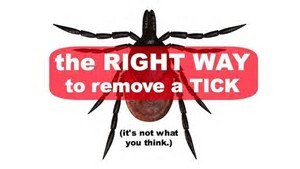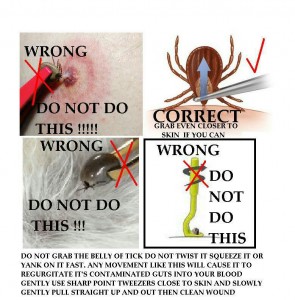Proper and Safe Tick Removal
 In last week’s blog “Let’s Talk Ticks”, we discussed how ticks “quest” to find a host and that even with preventatives on, you or your pet can still pick up a tick. This week, we are going to discuss what to do if you find a tick on you or your pet. So let’s learn about proper and safe tick removal!
In last week’s blog “Let’s Talk Ticks”, we discussed how ticks “quest” to find a host and that even with preventatives on, you or your pet can still pick up a tick. This week, we are going to discuss what to do if you find a tick on you or your pet. So let’s learn about proper and safe tick removal!
Do NOT:
- Allow the tick to complete their feeding and then fall out. This allows time for the tick to spread dangerous diseases.
- Put irritating substances on the tick or burn the tick while it is still attached to you or your pet. This causes the tick to regurgitate the contents of the digestive tract and is more likely to result in the spread of dangerous diseases.
- Twist the tick to remove it. This irritates the tick and can cause portions of the mouth parts to break off and become lodged in the skin resulting in irritation and infection.
Do:
- Perform a tick search after every time you are outside. This minimizes the chance that ticks will attach and start feeding.
- Isolate any ticks and promptly remove them. This minimizes the amount of time that the tick spends feeding.
- Use the following technique to safely remove any attached ticks.

- Immerse the tick in a sealed container of rubbing alcohol or burn the tick AFTER it is removed. This ensures that it will not feed on anyone else or reproduce.
- Wash the area with soap and water. This cleans the area and helps prevent infection.
- Monitor the area for swelling, redness, or rash. These are signs of tick borne disease and indicate that you may have contracted something from the tick while it was feeding.
- Go to the doctor (or have your pet visit their veterinarian) if you observe any signs of illness. This ensures that you will get prompt care if you or your pet have become ill from a tick borne disease. If you do seek medical attention, be sure to tell the doctor that you were bitten by a tick.
Hopefully this helps with removing any of these pesky pests should you or your pet come across one and as always, stay safe!


No comments